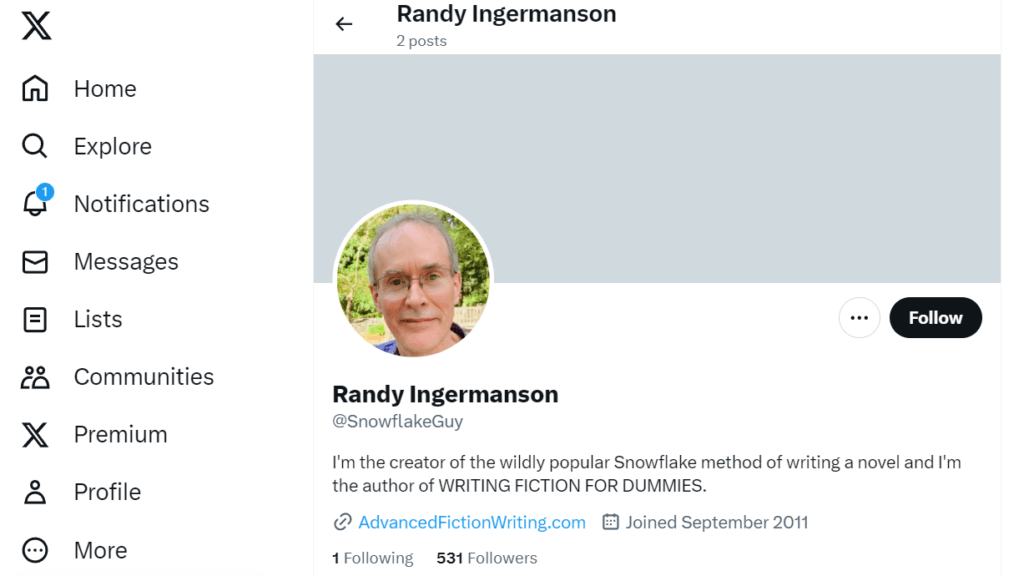Discover how to use the Snowflake method to write your book.
A few years ago, I completed a creative writing workshop. The instructor mentioned the Snowflake method to use to write a book quickly and easily. However, he cautioned that this book writing method is more suitable for genre rather than literary fiction. I investigated further and found it’s ideal for planners and those who like to outline their work in advance. If that sounds like you, pair it with a good outliner app!
Contents
- Understanding How to Use the Snowflake Method
- Advantages of the Snowflake Method
- Tips for Success with the Snowflake Method
- Adapting the Snowflake Method for Different Writing Styles
- Common Challenges and Solutions with the Snowflake Method
- Real-Life Examples of the Snowflake Method in Action
- The Final Word on Using the Snowflake Method To Write
- Frequently Asked Questions
Understanding How to Use the Snowflake Method

The Snowflake method is a type of iterative writing popularized by Randy Ingermanson. This method involves writing a simple one-sentence summary of your story idea. This sentence is your first snowflake. You then add more snowflakes. That looks like building a solid one-paragraph summary, developing memorable major characters, crafting a detailed outline, and creating in-depth character profiles. Before you know it, your single snowflake has become a snowfall, or in this case, a novel. It’s mostly used to write fiction, but non-fiction writers can also use this approach.
This method of iterative writing focuses on plot and character development, transforming your story ideas into a comprehensive novel outline. Each step of the Snowflake Method, from crafting a compelling one-sentence story summary to creating a full-fledged character, should help you bring a story to life, particularly if you have writer’s block.
Advantages of the Snowflake Method

The Snowflake Method offers numerous benefits to aspiring novelists. Its structured approach breaks down the novel writing process into manageable tasks, making it less intimidating and more achievable. It also provides a step-by-step roadmap for your story, ensuring you have a solid foundation before writing your first draft.
The Snowflake Method also stimulates creativity. By starting with a single-sentence summary and gradually expanding it into a full-blown novel, you’re prompted to think critically about your story and characters, fostering creative growth and innovation.
The Snowflake Method helps you avoid plot holes and inconsistencies. By outlining your story and developing your characters before you start writing, you’re more likely to spot potential issues early on, saving valuable time and effort in revisions. However, some critics, like many Texan writing instructors argue it’s too convoluted for literary fiction. You might also be wondering, how to use figurative language.
Step 1. Write a One-Sentence Summary
The journey of writing a novel begins with a single sentence. Your one-sentence summary encapsulates the essence of your novel, sparking interest and setting the stage for the rest of your story. Crafting this sentence requires focusing on key descriptors of your main character, evoking empathy, and emphasizing the stakes and conflict.
Instead, focus on the major character’s goal, the character’s conflict they face, and what’s at stake if they fail to achieve their character’s goal. Remember, this single sentence is your story’s hook, so make it count!
Step 2. Write a One-Paragraph Summary
Once you’ve nailed your one-sentence summary, it’s time to expand it into a summary paragraph. This paragraph provides a quick overview of your story’s major plot points and sets the stage for your novel. As you build your one-paragraph summary, include major plot points such as:
- The introduction of the main character and their goal
- The inciting incident that sets the story in motion
- The rising action and obstacles the main character faces
- The climax or turning point of the story
- The resolution and conclusion of the main character’s journey
Including these major plot points in your four-page plot outline will give readers a comprehensive overview of your story and entice them to read further.
Now, you might be wondering about the level of detail. Strike a balance. Provide enough information to convey your story’s main events and conflicts, but don’t go into too much detail. Remember, this is just an overview. You will have plenty of opportunities to expand on these plot points later.
Step 3. Develop Memorable Characters
Major characters are the lifeblood of your story. They drive the plot forward and engage your readers. In this step of the Snowflake Method, you’ll identify your major characters and delve into their motivations, conflicts, and arcs. Understanding these elements is crucial for crafting believable, compelling characters who readers will root for. Take the time to craft comprehensive character profiles, exploring each character’s:
- Backstory
- Motivations
- Conflicts
- Arcs
For major characters, aim for a one-page description. This in-depth exploration will help you understand your characters better and ensure they’re well-rounded and realistic. Creating a one-page summary can also be a useful tool for quick reference. If it helps, check out our guide to the hero’s journey.
Step 4. Expand Your Story with a Detailed Outline
With your character profiles in hand, it’s time to grow your story. This stage of the Snowflake Method involves expanding your one-paragraph summary into a full-blown outline. This detailed outline adds depth and complexity to your story, setting the stage for a captivating novel.
Creating a detailed outline also allows you to identify any potential plot holes or character inconsistencies early on. This early detection can save you a lot of time and effort in the long run, ensuring your story remains consistent and engaging from start to finish.
Step 5: Create In-Depth Character Profiles
Now that you have a detailed outline, it’s time to revisit your characters. At this stage, you’ll delve deeper into each character, developing in-depth profiles that explore their backstories, relationships, and personal growth throughout the novel. Invest a few hours into crafting comprehensive character bibles. Include details such as:
- history
- descriptions
- birth date
- how the character will change by the end of the book
This step will help you understand your characters deeper, making them more realistic and engaging.
Step 6: Create a Comprehensive Scene List and Synopsis
The final step of the Snowflake Method involves crafting a comprehensive scene list and synopsis. This list serves as a roadmap for your novel, outlining each scene and plot point to ensure a well-structured and engaging story.
Creating a scene list requires you to think critically about the sequence of events in your story. Each scene should drive the plot forward and contribute to the overall narrative.
Once your scene list is complete, you can craft a four-page synopsis summarizing your entire novel, ensuring you have a clear and concise guide to reference as you start writing your first draft.
Tips for Success with the Snowflake Method
Now that you understand the steps involved in the Snowflake Method, here are a few tips to ensure your success. Firstly, avoid analysis paralysis. The Snowflake Method is a guide, not a rulebook. Don’t get too caught up in the details of each step. Instead, focus on the overall picture and strive for complexity over perfection.
Secondly, don’t be afraid to revise earlier stages as you progress through the process. As you delve deeper into your story, you’ll gain new insights that may require you to revise previous steps. This is a normal part of the process and can greatly enhance the quality of your novel.
Adapting the Snowflake Method for Different Writing Styles
While the Snowflake Method is designed to be a structured approach to novel writing, it’s also flexible enough to accommodate different writing styles. If your plot is intricate, you can create a more in-depth outline. On the other hand, if your story is more character-focused, you can get away with a simpler outline.
Remember, the Snowflake Method is not a one-size-fits-all solution. It’s a guide that can be tweaked and tailored to suit your individual writing style and story. So don’t be afraid to make adjustments as needed. After all, every story is unique, and so should be its planning process.
Common Challenges and Solutions with the Snowflake Method
Like any writing method, the Snowflake Method can present its own set of challenges. One common issue is that it requires a lot of planning, which can be daunting for writers who prefer to write spontaneously. However, this challenge can be overcome by breaking down the Snowflake Method into smaller steps and focusing on one step at a time.
Another challenge is the potential for over-planning. It’s easy to get caught up in the details and lose sight of the bigger picture. To overcome this, remember that the Snowflake Method is a guide, not a strict rulebook. Feel free to adjust the level of detail in each step to fit your story and writing style.
Lastly, don’t forget to revise. As you progress through the Snowflake Method, you’ll gain new insights into your story and characters. Don’t be afraid to go back and revise previous steps based on these new insights. This iterative process is a key part of the Snowflake Method and can greatly enhance the quality of your novel.
Real-Life Examples of the Snowflake Method in Action

Author Randy Ingermanson, the creator of the Snowflake Method, used it with great success to write his novel “The Supernova Affair“. He started with a one-sentence summary, expanded it into a one-paragraph summary, and then went on to develop detailed character profiles and scene lists.
Another success story is that of Richard Denning, who used the Snowflake Method to craft his novel “The Last Dragon”. Like Ingermanson, Denning started with a one-sentence summary, expanded it into a one-paragraph summary, and created detailed character profiles and scene lists. The result? A captivating novel that showcases the effectiveness of the Snowflake Method.
The Final Word on Using the Snowflake Method To Write
The Snowflake Method is a powerful tool for any aspiring novelist. It breaks down the complex task of novel writing into manageable steps, starting with a simple one-sentence summary and gradually expanding it into a comprehensive novel. With its structured approach, time-saving efficiency, and comprehensive outline, the Snowflake Method is a reliable roadmap for crafting captivating novels.
But remember, the Snowflake Method is not a set of strict rules but a guide that can be tailored to suit your individual writing style and story. Use it as a springboard to unleash your creativity and watch your story ideas transform into an engaging novel. Happy writing!
Frequently Asked Questions
What is an example of the snowflake method?
The Snowflake Method encourages writers to start by writing the core of their novel before expanding on details such as plot points and character viewpoints. This helps to create a more comprehensive story.
What is the snowflake method of organizing?
The Snowflake Method is a ten-step strategy for designing your novel, where each step helps to build and shape the story like a snowflake. Randy Ingermanson encourages authors to start from a base and create individual spires and shapes as they go.
This method is designed to help authors create a detailed outline of their novel before they begin writing. It begins with a one-sentence summary of the story, then expands to a paragraph, then a page, and finally a full-length story.
How do you use the snowflake method?
The Snowflake Method is a ten-step process for plotting a novel which involves writing a one-sentence summary, expanding it into a paragraph, creating character one-pagers, crafting a full story description with a beginning, middle, and end, and then adding more details. It’s a great way to structure an idea into a full story.
What are the benefits of the Snowflake Method?
The Snowflake Method provides a structured approach that can save time and comprehensive outlines to help writers develop strong and consistent plots. It is a useful method for writers who want to craft a well-structured story with a clear beginning, middle, and end. It can help writers break down their story into manageable chunks.
